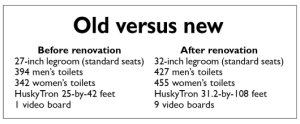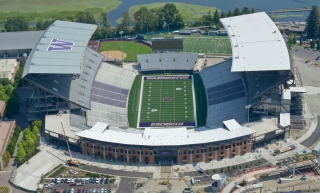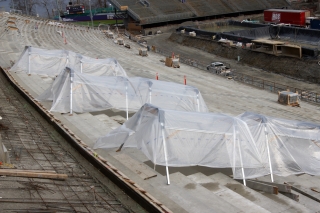|
Subscribe / Renew |
|
|
Contact Us |
|
| ► Subscribe to our Free Weekly Newsletter | |
| home | Welcome, sign in or click here to subscribe. | login |
Construction
| |

September 5, 2013
A winning game plan for rebuilding Husky Stadium
Turner Construction Co.
After more than a year of preconstruction services for the University of Washington Husky Stadium renovation project, Turner Construction Co. began construction in November 2011.
The new stadium has 70,000 seats and 30 new suites, including luxury and patio suites. It also has new club seats, a press box, 80,000-square-foot football operations building, new concession stands and restrooms, a commercial kitchen and landscaping.
The 930,000-square-foot project included complete demolition and reconstruction of the lower bowl and south grandstand; renovation of the Don James Center; installation of permanent east end zone seating; and construction of a 200-stall, 75,000-square-foot parking garage below the south bowl and stands. The south grandstand also has a 33,000-square-foot sports medicine clinic.
Developer-led approach
For the first time in its athletics history, the UW chose a developer-driven model for construction. The university awarded the work in August 2010 to Wright Runstad & Co., who teamed with 360 Architecture, Magnusson Klemencic Associates and Turner.
There were benefits to the UW for using the developer-driven model versus a typical capital projects approach. One of the biggest was that subcontractors could be selected based on qualification and value rather than the lowest bid. Through this process the contractor was able to work with the developer and owner to select key subcontractors. A group of these “partner subcontractors” even participated in the proposal process.
Building these partnerships early in the process allowed for immediate planning, coordination and budget establishment.
The other benefits for UW Athletics were:
1. Added expertise brought by a professional developer.
2. Streamlined process with more control over design decisions.
3. Flexibility in choosing the right partners.
Against the clock
The project was awarded in August and by October the team was fully integrated into planning, coordinating and designing. While finishing up preconstruction in summer 2011, Turner was able to mobilize on site and complete underground utility work early. Execution of this work set the stage for an August 2013 completion by allowing Turner to begin critical path work on day one of the master schedule.
| THE TEAM |
|
Developer:
Wright Runstad
Architect:
360 Architecture
General contractor:
Turner Construction
Structural engineer:
Magnusson Klemencic Associates
Electrical engineer:
Highley Group
|
Keeping on the critical path throughout the project was accomplished by the entire team using a variety of lean processes.
Lean, effective, efficient
Working together to promote a clean and efficient construction site was instrumental in meeting the rigorous schedule. By embracing lean principles, Turner cut time, labor and material usage across the board, creating savings that could be put back into the project as improvements.
Weekly pull-planning sessions with the subcontractors allowed Turner to anticipate and work through potential conflicts prior to beginning work in the field.
Collaboration between the trades on how to efficiently prefabricate, share work, and put it in place helped Turner ensure work would be completed on schedule. This proactive approach also kept the team focused on providing innovative solutions in order to get the highest quality outcome for the stadium.
Pre-planning was also a major factor in keeping UW students and construction workers safe. Following Turner's LIFE (Live Injury Free Everyday) safety commitment, field staff began each day with daily huddles, and each person attended a Turner safety orientation and behavior-based safety coaching.
The result? Nearly 1 million hours were logged without a lost-time injury.
| Tackling the numbers |
|
97 percent
of waste generated on-site was recycled
375 workers
onsite at the peak of construction
2,600 tons of rebar
(equivalent to 26,000 200-pound wide receivers)
7,500 tons of structural steel
(equivalent to 46,000 325-pound defensive linemen)
40,000
cubic yards of concrete
|
Another of Turner's lean contributors was an “everything on wheels” approach. In a large project with hazardous conditions, having everything on wheels allowed crews to move heavy materials to keep paths clear and materials easily at hand. It also allowed for orderly and clean storage of materials.
Self performing
As the concrete subcontractor, Turner was the largest presence on site. Having control over the concrete cast-in-place seating bowl contributed to its ability to control the schedule and lead by example in safety and quality. The concrete team developed a portable tent system to move up the bowl as pours were made to ensure that typical Seattle weather did not impact the pour schedule or concrete quality.
Thoughtful coordination
Husky Stadium renovation is not the only construction project near the busy intersection of Montlake Boulevard and Northeast Pacific Street: Sound Transit's UW Station and the Rainier Vista pedestrian bridge projects were also under construction. Coordination from an early stage was a key in allowing all projects to proceed without disrupting each other.
Along with ensuring Turner was being proactive in communication with its construction neighbors, the project team made it a priority to accommodate UW Athletics operations during construction. Turner worked with the university to maintain access to the football practice field and softball field during construction. Some work was held back to avoid interference with practice days and certain times of the season.

The Husky Stadium renovation was a monumental project. It is a project built for the fans to enjoy for generations to come. Project success was due to the team's dedication to safe, collaborative and innovative solutions and, most importantly, to working together.
Partner subcontractors were: Hos Brothers, Fairweather Masonry, Canron, The Erection Co., Walters & Wolf, Performance Contracting Inc., Auburn Mechanical, PSF Mechanical, Prime Electric and Holmes Electric.
Chuck Baldwin, Turner Construction project executive, has 35 years of industry experience. He has focused his career with Turner on building world-class sporting venues.
Previous columns:
- A conservative approach has helped Deeny weather 75 years — and the Great Recession, 08-29-2013
- Architects call on Big Ass Fan Co. to save energy in local buildings, 08-22-2013
- Redmond planners use videos to help people understand new projects and the city's vision, 08-15-2013
- Industrial Resources choreographs crews and cranes to pull an engine, 08-08-2013
- Why contractors should care about the Consumer Protection Act, 08-01-2013
- Contractors face labor shortage as construction industry slowly rebounds, 07-25-2013
- Portland low-income agency takes a shot at health-care development, 07-18-2013
- Keeping your cool in the media ‘hot seat', 07-11-2013




